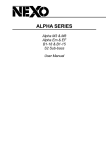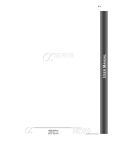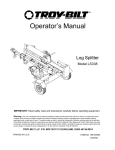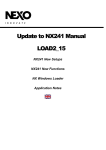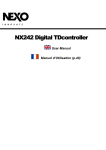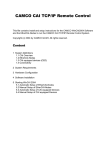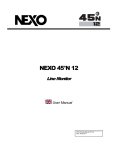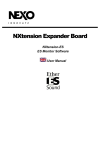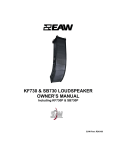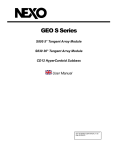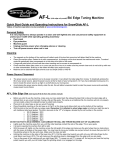Download Alpha AlphaE User Manual
Transcript
ALPHA SERIES
Alpha M3 & M8
Alpha Em & EF
B1-18 & B1-15
S2 Sub-bass
User Manual
PAGE 2/37
INTRODUCTION
INTRODUCTION
3
ALPHA SERIES DESCRIPTION
3
LOUDSPEAKERS
NEXO TDCONTROLLERS
THE X-BOW FLYING SYSTEM
3
4
4
GENERAL SET-UP INSTRUCTIONS
5
SPEAKER WIRING
FLYING THE SYSTEM
TDCONTROLLERS SETTINGS
INITIAL SET-UP PRECAUTIONS
5
6
9
10
ALPHA ARRAYS - SOME BASIC RULES
11
ALPHA S2 PLACEMENT
SPL VERSUS FREQUENCY
SPL VERSUS DISTANCE
DIRECTIVITY - COVERAGE
11
11
11
14
AMPLIFIERS
16
POWER
CURRENT RATING
AMPLIFIER GAINS
GAIN VALUE
ADVANCED PROTECTIONS
16
16
16
17
17
PASSIVE CROSSOVER FUSES
18
TECHNICAL SPECIFICATIONS
19
ALPHA S2
ALPHA B1-15 / B1-18
ALPHA M3 / M8
ALPHA EM / EF
DIRECTIVITY TABLES
19
20
21
22
23
CURVES
24
ALPHA S2
ALPHA B1-18
ALPHA B1-15
ALPHA M3
ALPHA M8
ALPHA EM
ALPHA EF
24
24
24
25
28
31
31
DIMENSIONS
34
TRANSPORT
35
CONNECTION DIAGRAMS
36
ALPHA SERIES USER MANUAL V1.0
DATE: 14/01/00 18:27
PAGE 3/37
INTRODUCTION
INTRODUCTION
Thank you for selecting NEXO Alpha Series. This manual is intended to provide you with
necessary and useful information about your Alpha System:
•
S2
•
B1-15, B1-18
•
M3, M8
•
EM, EF
Please devote some attention to reading this manual. A better understanding of some specific
features of the Alpha Series will help you to operate your system to its full potential.
This manual is intended to be comprehensive, and we hope that it will satisfy your requirements.
Should you require further information, please contact your NEXO agent.
Alpha Series description
Loudspeakers
The Alpha range includes the following speakers:
•
The S2 Sub-bass is a double 18-inch resonator loaded sub-bass, dedicated to very low
frequency reproduction (< 80 Hz).
•
The B1-15 & B1-18 are complex loaded (bass-reflex & exponential horn) bass cabinets;
the B1-15 houses one 15-inch driver, while the B1-18 houses one 18-inch driver;
frequency response ranges from 40 Hz up to 200 Hz.
•
The Mid-high M3 & M8 are concentric horn cabinets dedicated to the 200 Hz - 20 kHz
frequency range reproduction; the MF range is handled by two exponential horn loaded
10-inch drivers whose response is optimised by two Nexo designed phase plugs; the HF
range is handled by one constant directivity horn loaded two-inch Neodymium driver. M3
coverage is 35° (H) x 35°(V), M8 75° (H) x45° (V).
•
The Mid-high EM forms part of the recently introduced Alpha E Series; its size and powerrating is smaller than that of the Alpha M3 & M8; the mid range is handled by an
exponential horn loaded 10’’ driver, while the HF range is handled by a constant directivity
horn loaded ceramic 2’’ driver. Alpha EM coverage is 75°x30°.
•
The compact EF is dedicated to the full audio range reproduction 40 Hz – 20 kHz; it
consists of one EM and one B1-18 stacked in a monoblock compact format.
Alpha cabinet formats are designed for optimal array assembly (see section “DIMENSIONS” p.34); all
the cabinets have the same width and depth; height is in multiples of 200 mm UNITS.
•
Six UNITS (1200 mm): Alpha S2, Alpha EF.
•
Four UNITS (800 mm): Alpha B1-18.
ALPHA SERIES USER MANUAL V1.0
DATE: 14/01/00 18:27
PAGE 4/37
ALPHA SERIES DESCRIPTION
•
Three UNITS (600 mm): Alpha B1-15, Alpha M3, Alpha M8.
•
Two UNITS (400 mm): Alpha EM.
Nexo TDcontrollers
The Alpha Series speakers are associated with the NX241 Digital TDcontroller, which can be
configured to provide comprehensive control of the above, mentioned cabinets. For a complete
description of this unit please refer to the "NX241 User Manual". You may also use one of the
following analogue TDcontrollers that preceded the NX241. Please refer to the corresponding user
manual or contact your NEXO agent for more information on these products.
•
Sub TDcontroller for use with Alpha S2;
•
Alpha TDcontroller for use with Alpha B1-15, B1-18, M3 & M8;
•
AlphaE TDcontroller for use with Alpha B1-18, EM & EF;
This manual will only refer to the NX241 TDcontroller. Please remember that the NX241 Digital
TDcontroller is a software-based product for which regular updates will be published. Please
consult the NEXO web site for the latest software releases.
The X-BOW flying system
The design of the X-BOW flying system has been optimised for the dispersion specifications of the
Alpha range, its mechanical characteristics match accurately the acoustical properties of the
speakers.
The concept of this flying system enables efficient array assembly, with minimum space between
cabinets, thus reducing edge diffraction.
The X-BOW flying system includes four main components, references are:
•
ALXBOW: main chassis (1);
•
ALXKIT: hinge (1) and cable links (2);
•
ALXBRIDLE: D-ring (1) and leg chains (3);
•
ALXCASE: flight-case for a complete X-BOW flying kit (capacity: 4 X-BOWs).
ALPHA SERIES USER MANUAL V1.0
DATE: 14/01/00 18:27
PAGE 5/37
GENERAL SET-UP INSTRUCTIONS
General Set-up Instructions
Speaker Wiring
Connectors
The loudspeakers are connected via SPEAKON connectors, NL4FC and NL8FC (not supplied). A
wiring diagram is printed on the connection panel located on the back of each cabinet. The pins of
the SPEAKON sockets are identified in/out and connected in parallel within the enclosures. A
single 8-conductor cable carries all four bands required by the Alpha M3/B1/S2 system and the
cabinet connectors allow all three types of cabinet to be safely linked at the loudspeaker end. (See
Connections Diagrams at the end of this manual).
NB: The Alpha S2 back panel features only one 4-pin SPEAKON connector in order to prevent
accidental parallel connection: very few amplifiers are able to drive such low impedance loads at
the required power level.
B1/15
B1/18
S2
EM
EF
M3
M8
S2
B1-15 / B1-18
M3 / M8
EM / EF
1±
In / Out
VLF
To VLF (S2)
To VLF (S2)
To VLF (S2)
2±
Not
connected
In / Out LF (B1)
To LF (B1)
To LF (B1)
SP4
1±
-
To VLF (S2)
-
-
#2
2±
-
In / Out LF (B1)
1±
-
-
In VLF (S2)
In / Out VLF (S2)
2±
-
-
In / Out LF (B1)
CONNECTOR
SP4
#1
SP8
#1
SP8
#2
3±
-
-
-
In / Out MF
In / Out LF (B1)
P: In / Out MF+HF
A: In / Out MF
P: Not connected
4±
-
1±
-
-
In VLF (S2)
In VLF (S2)
2±
-
-
In / Out LF (B1)
In / Out LF (B1)
3±
-
-
In / Out MF
4±
-
-
In / Out HF
P = MF-HF passive / A = MF-HF active
ALPHA SERIES USER MANUAL V1.0
DATE: 14/01/00 18:27
-
In / Out HF
A: In / Out HF
P: In / Out MF+HF
A: In / Out MF
P: Not connected
A: In / Out HF
PAGE 6/37
GENERAL SET-UP INSTRUCTIONS
Cables
Nexo recommends the exclusive use of multi-conductor cables to connect the system: the cable kit
is compatible with all the cabinets, and there is no possible confusion between VLF, LF, MF and
HF sections.
Cable choice consists mainly of selecting the correct cable section (size) in relation to the load
resistance and the cable length. Too small a cable section will increase its serial resistance; this
would induce power-loss and response variations (damping factor).
For a serial resistance less or equal to 4% of the load impedance (damping factor = 25), the
maximum cable length is given by:
2
Lmax = Z x S S in mm , Z in Ohm, Lmax in meters
The table below indicates these values, for 3 common sizes.
Load Impedance (Ω)
2
Cable section
Maximum Length (meters)
3
4
6
8
12
16
1,5 mm² (AWG #14)
3
4.5
6
9
12
18
24
2,5 mm² (AWG #12)
5
7.5
10
15
20
30
40
4 mm² (AWG #10)
8
12
16
24
32
48
64
IMPORTANT NOTE: Long speaker cables induce capacitive effects that impair the quality of audio
signals. If long speaker cables must be used, ensure that they do not remain coiled while in use.
Flying the System
Alpha Series loudspeakers are equipped with steel anchor plates that can be fitted with NEXO XBOW flying accessories. The X-BOW Flying Manual must be thoroughly read before flying
the system.
The following points are designed to remind the user of safe practice when flying the X-BOW
system. They cannot address every possible circumstance in which the system might be deployed;
therefore the user must always apply his or her knowledge, experience and common sense. If in
any doubt, seek advice from your NEXO agent.
Flown Systems Safety
•
Always inspect all the X-BOW components and cabinet Fly Rails for damage before
assembly. Pay special attention to the lifting points, trombone sockets and safety clips. If
you suspect that any of the components are damaged or defective, DO NOT USE THE
AFFECTED PARTS. Contact your supplier for replacements.
•
Read the X-BOW Flying manual carefully. Also, be familiar with the manuals and safe
working procedures for any ancillary equipment which will be used with the X-BOW
system such as hoists, steel wires and other rigging components.
•
Ensure that all local and National regulations regarding the safety and operation of flying
equipment are understood and adhered to. Information on these regulations can usually
be obtained from Local Government Offices.
•
When deploying the X-BOW system always wear protective headwear, footwear and eye
protection.
ALPHA SERIES USER MANUAL V1.0
DATE: 14/01/00 18:27
PAGE 7/37
GENERAL SET-UP INSTRUCTIONS
•
Do not allow inexperienced persons to handle X-BOW flying systems. Installation
personnel should be trained in loudspeaker flying techniques and should be fully
conversant with this manual.
•
Ensure that motor hoists, hoist control systems and ancillary rigging components are
currently certified as safe and that they pass a visual inspection prior to use.
•
Ensure that public and personnel are not allowed to pass beneath the system during the
installation process. The work area should be isolated from public access.
•
Never leave the system unattended during the installation process.
•
Do not place any object, no matter how small or light, on top of the system during the
installation procedure. The object may fall when the system is flown and is likely to cause
injury.
•
Secondary safety steels must be installed once the system has been flown to the
operating height. Secondary steels must be fitted irrespective of the local safety standards
applicable to the territory.
•
Do not fly the system over areas to which the audience has access.
•
Ensure that the system is secure and prevented from pivoting about the motor hoist. Avoid
any form of dynamic loading to the assembly.
•
NEVER attach any item to the X-BOW other than the NEXO X-BOW accessories.
•
When flying outdoor systems ensure that the system is not exposed to wind or snow loads
and is protected from rainfall.
•
The X-BOW requires regular inspection and testing by a competent test centre. NEXO
recommend that the system is load tested and certified annually or more frequently if local
regulations require.
•
When de-rigging the system ensure that the same duty of care is given to the procedure
as for the installation. Pack X-BOW components carefully to prevent damage in transit.
•
Correct training is fundamental to safe practise when working with loudspeakers flying
systems. NEXO recommend that users contact local industry associations for information
on specialist course. Information for UK and International training agencies can be
obtained by contacting:
•
The Production Services Association (PSA),
School Passage,
Kingston-upon-Thames,
KT1 SDU Surrey,
ENGLAND
Telephone: +44 (0) 181 392 0180
Ground Stack Safety
Statistically, many more injuries occur due to unstable ground stacked PA systems than those
associated with flown systems. There are several reasons for this fact, however the message is
clear:
ALPHA SERIES USER MANUAL V1.0
DATE: 14/01/00 18:27
PAGE 8/37
GENERAL SET-UP INSTRUCTIONS
•
Always survey the supporting structure upon which a ground stack is to be built. Always
look beneath PA wings to inspect the deck support and if necessary ask for the stage
scrims and dressings be removed to allow access.
•
X-BOW components should be used to stabilise ground stacks and to ensure that
cabinets remain securely registered to each other. The X-HINGE can be used to connect
Alpha cabinets both vertically and horizontally at the rear and horizontally at the front
edge. In addition the Fly Track can be used as a connection point for a safety wire to a
secondary structure.
•
If the stage surface slopes, as it does in some theatres, ensure that the system is
prevented from sliding forwards due to vibration. This may require the fitting of timber
battens to the stage floor.
•
For outdoor systems ensure that that the system is protected from wind forces which
might cause the ground stack to become unstable. Wind forces can be huge, especially
upon large systems, and should never be underestimated. Observe meteorological
forecasts, calculate the likely effect upon the system prior to erection and ensure that the
system is secured appropriately.
•
Take care when stacking cabinets. Always employ safe lifting procedures and never
attempt to build stacks without sufficient personnel and equipment.
•
Never allow anyone, whether operators, artists or members of the public to climb onto a
ground stacked PA system. Anyone who needs to climb over 2m high should be fitted with
suitable safely equipment including a clip-on harness. Please refer to local Health and
Safety legislation in your territory. Your dealer can help with advice on access to this
information.
•
Apply the same attention to all safety matters when de-stacking systems.
•
Be aware that safety procedures are as important in the truck and in the warehouse as
they are at the venue.
ALPHA SERIES USER MANUAL V1.0
DATE: 14/01/00 18:27
PAGE 9/37
GENERAL SET-UP INSTRUCTIONS
TDcontrollers settings
The Alpha Series cabinets will not perform correctly without their associated TDcontrollers. Sound
quality and reliability are totally dependent on the correct use of the TDcontrollers, in association
with the Nexo instructions, provided.
All manuals & associated technical notes must be read before set-up. Please contact your NEXO
agent for any literature inquiry.
NX241 Digital TDcontroller
The digital NEXO NX241 controller is able to drive the entire current Nexo range (PS & Alpha
series). The following set-ups are supported (at the time of publication).
Alpha Series
ALPHATD B1+M3
Configure Input A to drive a 3-Way Alpha System.
ALPHATD S2+B1+M3
SubTD S2-63Hz
Configure Input A to drive a 4-Way Alpha System.
ALPHATD S2+B1+M3
SubTD S2-80Hz
Configure Input A to drive a 4-Way Alpha System.
ALPHATD S2+B1+M3
S2-63Hz AUX inB
Configures Input B (right) to drive the SUB channel independently.
ALPHATD S2+B1+M3
S2-80Hz AUX inB
Configures Input B (right) to drive the SUB channel independently.
Alpha E Series
AlphaE STEREO
Configures 2 passive Alpha EM + 2 B1-18 (or 2 Alpha EF) in stereo.
AlphaE MONO
Configures Input A to drive 1 passive Alpha EM + B1-18 + S2 sub
cabinet. (Channel 4 is unused).
Very important:
Due to the DSP processing time, analogue Sub TDcontroller / Alpha TDcontroller /
AlphaE TDcontroller are incompatible with the Digital NX241and should never be
used in conjunction to control cabinets within the same array.
ALPHA SERIES USER MANUAL V1.0
DATE: 14/01/00 18:27
PAGE 10/37
GENERAL SET-UP INSTRUCTIONS
Initial Set-up Precautions
When running up a system particularly one which includes brand new cabinets for the first time the
power should be increased slowly to approximately 50% and the system operated at this level for
two hours. During the following two hours of operation the power level should be limited to
approximately 75%. This procedure allows the adhesives and suspensions within the loudspeaker
components to stabilise and will extend their working life.
In all cases, it is advisable to connect the loudspeakers only after all the other components have
been wired and are operating correctly. This is particularly important for the amplifiers and the
TDcontroller. It is a good practice to turn down all the amplifier gains before connecting the
cabinets and then turn them up again individually with a medium level music source fed into the
system. The sense LEDs of the corresponding TDcontroller channel should light up accordingly.
This will help to locate cabling errors, particularly channel line inversions, which would disable the
TDcontroller protections and may invalidate the warranty.
IMPORTANT
If more than one amplifier is being driven from an output of the NX241 controller only those
amplifiers which are not connected to sense inputs may be attenuated. If the sensed amplifier is
attenuated and the slave amplifiers are not severe system damage will result!
ALPHA SERIES USER MANUAL V1.0
DATE: 14/01/00 18:27
PAGE 11/37
ALPHA ARRAYS - SOME BASIC RULES
Alpha Arrays - Some Basic Rules
The concept of arraying speakers derives from two requirements:
•
Increased sound pressure level;
•
Extended coverage area.
Array behaviour is very complex, and a bad design can lead to very poor results. The Alpha
system was designed to be flexible, allowing the user to optimise the design for a dedicated
situation; its development included a long measurement program on a very large variety of arrays.
Below are some simple rules that the user should respect.
Alpha S2 Placement
The nominal efficiency data for Alpha S2 is given for when positioned on the floor (half-space).
When flown the acoustic output on axis will be 3 dB lower and if positioned in a corner the acoustic
output on axis will increase by 3 dB.
SPL Versus Frequency
Array frequency response is strongly related to wavelength and array architecture.
•
At low frequencies, wavelength being very large in relation to the size of the cabinets,
speakers set close to each other will always radiate in phase. The gain in sound pressure
level LGSPL will be of 6 dB per doubling, i.e. if n Alpha S2 or B1 are installed:
LGSPL(20Hz-100Hz) = 20 log10(n)
•
In the mid frequency range, the gain depends on the configuration of the array, and will
range from 3 to 6 dB per doubling, i.e. for n Alpha M3, M8, EM or EF:
10 log10(n) ≤ LGSPL(100Hz-1kHz) ≤ 20 log10(n)
•
At high frequencies, wavelength being short in relation to the size of the cabinet, the gain
level is smaller: no gain will be obtained for cabinets angled at their nominal coverage,
maximum gain will be obtained for n cabinets pointing in the same direction. Therefore,
the gain will range from 0 to 3 dB per doubling; for n Alpha M3, M8, EM or EF:
0 ≤ LGSPL(1kHz-10kHz) ≤ 10 log10(n)
SPL Versus Distance
In open-air conditions, the level of sound at a given distance is related to the following parameters:
•
The size and the geometry of the source, which determines the shape of the sound wave
(spherical, cylindrical, plane);
•
Hygrometry and temperature: viscosity of the air and thermal conduction cause an energy
loss increasing with frequency. This phenomenon is referred to as excess attenuation.
ALPHA SERIES USER MANUAL V1.0
DATE: 14/01/00 18:27
PAGE 12/37
ALPHA ARRAYS - SOME BASIC RULES
Single Cabinet
Lp(1m) being the sound pressure level at 1m, the level at a distance d (in meters) is given by:
Lp(d) = Lp(1m) - 20 log10(d)
Sound Pressure Level (dBSPL) / distance (meters)
110.00
100.00
90.000
80.000
70.000
60.000
1
10
100
• Single Cabinet SPL versus Distance
For example, if the level measured at 1 meter is Lp(1m) = 100 dBSPL, the level at 2 meters will be
94 dBSPL, 80 dBSPL at 10 meters and so on. Note that under these conditions of small source
and open air, the sound pressure level will be decreasing by 6 dB when doubling the distance.
Straight Vertical Array (long throw)
Some open-air applications might require loud level on a wide frequency range at a long distance.
It is then recommended to stack a large number of Alpha M3/M8/EM vertically. Up to a determined
distance - function of the frequency and the height of the stack -, the sound wave is cylindrical
(3dB/2d); it becomes progressively spherical (6dB/2d) above that distance.
• Transition from cylindrical to spherical wave front
Sound Pressure Level (dBSPL) / distance (meters)
110.00
100.00
90.000
80.000
70.000
60.000
1
ALPHA SERIES USER MANUAL V1.0
DATE: 14/01/00 18:27
10
100
PAGE 13/37
ALPHA ARRAYS - SOME BASIC RULES
Hygrometry and Temperature - Air Absorption
Under usual conditions, air absorption increases when relative humidity decreases and increases
when temperature decreases.
Air absorption gives a linear attenuation, i.e. a constant value of loss of dB per meter: if 1 dB is lost
from 10 to 20 meters, 2 dB will be lost from 20 to 40 meters, 4 dB from 40 to 80 meters and so on...
The tables below list these values for normalised frequencies, and various values of relative
humidity and temperature:
At 20°C:
[dB] loss / meter
Up to 1 kHz
2 kHz
4 kHz
8 kHz
16 kHz
RH 20%
0
0.02
0.06
0.20
0.66
RH 50%
0
0.01
0.03
0.08
0.27
RH 80%
0
0.00
0.02
0.05
0.17
Frequency (Hz) / Attenuation (dB)
10.000
0.0
-10.00
-20.00
-30.00
-40.00
20
100
1k
10k
20k
Air absorption over a 50m distance; RH=20%-50%-80%
At RH 50%:
[dB] loss / meter
Up to 1 kHz
2 kHz
4 kHz
8 kHz
16 kHz
10°C
0
0.01
0.04
0.13
0.43
20°C
0
0.01
0.03
0.08
0.27
30°C
0
0.01
0.02
0.06
0.19
AUDIO PRECISION
10.000
LEVEL(dBV)
vs
FREQ(Hz)
17 JUL 97 19:30:05
0.0
-10.00
-20.00
-30.00
-40.00
20
100
1k
10k
20k
Air absorption over a 50m distance; t=10°C-20°C-30°C
The speed of sound C varies with temperature according to the formula below:
C = 20 t° + 273
Where t° is the temperature in °C
The delay time between two sources spaced at a distance d is then:
ALPHA SERIES USER MANUAL V1.0
DATE: 14/01/00 18:27
∆t = C/d
PAGE 14/37
ALPHA ARRAYS - SOME BASIC RULES
Directivity - Coverage
The two main qualities one might expect from a cabinet for array constructions are:
•
A good directivity control in the mid and high frequency region, which guarantees the
steadiness of the interference region where dips and lobes occur;
•
A strong roll-off of the directivity function at the -6dB cut-off angle, which minimises the
size of the interference region.
The Alpha series cabinets were designed to respect these two criteria. Particularly, the Alpha M3
features a constant coverage angle +/- 5° from as low as 800 Hz up to 12 kHz, with high values of
dB loss / degrees at cut-off angle.
Directivity of Multiple Sources - What HAPPENS?
In order to understand the coverage behaviour of combined sources, wavelength must be related
to the space between sources.
The wavelength λ (in meters) of o sine wave is determined by:
λ = C/f
where f is the frequency of the sine wave
This gives: λ(20Hz) = 17 m, λ(100Hz) = 3.4 m, λ(1kHz) = 34 cm and λ(20kHz) = 1.7 cm
Interference
The distance between sources generates a path
length difference between the two signals that is nil
on axis and increases with the listening angle. If this
path length difference increases to half the
wavelength in a specific direction, the two signals
will cancel in that direction. This phenomenon is
often described as « interference ».
Path length
difference
Resulting directivity
At low frequencies -because wavelength is much larger than the spacing between sourcesinterference is generally not significant. However the directivity index will increase.
In the mid and high frequency range, where wavelength is comparable to spacing between
sources, the directivity polar plots will show dips and lobes. The amplitude of these lobes will
depend on the directivity of the individual sources and on their angulations.
Small Arrays (less than 4 Alphas M3 / M8)
The amplitude of the dips and the lobes is minimised when angling the cabinets at their nominal
coverage angle. If the angle is less than the coverage, the interference region will be larger, and if
the angle exceeds that value, there will be a « hole » between the cabinets.
It is therefore strongly recommended when using a small amount of cabinets to angle them at their
nominal coverage angle (Alpha M3: 35°x35°, M8: 75° x 45°; EM/EF: 75° x 30°).
ALPHA SERIES USER MANUAL V1.0
DATE: 14/01/00 18:27
PAGE 15/37
ALPHA ARRAYS - SOME BASIC RULES
The only situations where such arrays can be assembled with very little angle are long throw
applications (very small vertical coverage) because the interferences are less significant at large
distances from the array.
Large Arrays (4 Alphas M3 / M8 and above)
Construction of large arrays derives from important SPL requirements rather than large listening
angles: although the Alpha M3 is a high Q cabinet, 4 boxes are enough to cover a 140° horizontal
plane. Therefore, large arrays will usually assemble cabinets at less than their nominal coverage
angle.
Measurements and simulations show that when using a large amount of cabinets, the individual
behaviour of a cabinet will determine the roll-off on the limits of the coverage zone, and the
architecture of the array will be responsible for the behaviour in the coverage zone.
For examples of suitable cabinet configurations please refer to the Alpha System Flying Manual
and to subsequent technical notes.
ALPHA SERIES USER MANUAL V1.0
DATE: 14/01/00 18:27
PAGE 16/37
AMPLIFIERS
Amplifiers
Power
NEXO recommends high power amplifiers in all cases. Budget constraints are the only reason to
select lower power amplifiers. If an incident occurs on an installation without protection the fact that
amplifiers only generating half their rated output power (-3dB) are used will not change anything in
respect of possible damage. This is due to the fact that the RMS power handling of the weakest
component in the system is always 6 to 10 dB lower than the amplifier rating.
Current rating
It is very important that the amplifier behaves correctly under low load conditions. A speaker
system is reactive by nature, on transient signals like music it will require much higher
instantaneous current than its nominal impedance would indicate (four to ten times more).
Amplifiers are generally specified by continuous RMS power into resistive loads however the only
useful information in that respect is the specification into a 2-ohm load. It is possible to make an
amplifier listening test by loading them with twice the number of cabinets considered for the
application (2 speakers per channel instead of one, 4 instead of 2) and modulating at high level
(onset of clipping). If the signal does not noticeably deteriorate the amplifier is well adapted
(overheating after approximately ten minutes is normal but thermal protection must not operate too
quickly after starting this test).
Amplifier gains
Technical knowledge on the amplifiers to be used with the system is essential. This data is the key
to the correct alignment of the system. It is especially important to know the gain of all amplifiers
used in your set-up. The tolerance shall be about ±0,5 dB. In practice this can be difficult to achieve
because:
•
Some amplifier brands have an identical input sensitivity for models of different power
rating (this infers a different voltage gain for each model). For example a range of
amplifiers with different power outputs having a published input sensitivity of 775mV/0dBm
or 1.55V/+6dBm will have a wide range of actual gains, the higher the power, the greater
the gain.
•
Various other brands may offer constant gain but only within a given product range for
example they may fit only fixed input sensitivity on their semi-professional amps.
•
Even if a manufacturer applies the constant gain rule to all models, the value selected will
not necessarily be the same as that chosen by other manufacturers.
•
Some products can exhibit manufacturing tolerances for the same model of ±1dB or more.
Some amplifiers may have been modified, possibly without any label indicating the new
values and some may have gain switches fitted internally where it is impossible for the
user to verify the actual setting without opening the amplifier casing. In cases where you
don't know the gain of your amplifier (or want to check it) please read the following
instructions.
1. Unplug any cabinet from the amp
2. With a signal generator feed a sine wave at 1000Hz at a known voltage (say
0.5V) to the input of the amplifier under test.
ALPHA SERIES USER MANUAL V1.0
DATE: 14/01/00 18:27
PAGE 17/37
AMPLIFIERS
3. Measure the Voltage at the output of the amplifier.
4. Calculate the gain using the formula
Gain = 20 * LOG10(Vout/Vin)
Some examples:
Gain
20dB
26dB
32dB
0.1V
1V
2V
4V
37dB (1.4V
sensitivity /
1350Wrms)
7.1V
0.5V
5V
10V
20V
35.4V
1V
10V
20V
40V
70.8V
Vin
Remember that constant sensitivity settings will give a different gain value when the amplifier
power is different.
Gain value
NEXO recommends low gain amplifiers: +26dB is recommended, as it is at the same time
adequately low and quite common amongst amplifier manufacturers. This gain setting improves
signal to noise ratio and allows all preceding electronic equipment, including the TDcontroller, to
operate at optimum level. Remember that using a high gain amplifier will proportionally raise the
noise floor by the same amount.
Advanced protections
Some high-end amplifiers may have some advanced functions similar to those found in the NX241
TDcontroller ("loudspeaker offset integration", "limiter", "compressor"...). These functions are not
adapted to specific system requirements and may interfere with the complex protection algorithms
used in the NX241. NEXO do not advise using other protection systems in conjunction with the
NX241 and they should be disabled.
ALPHA SERIES USER MANUAL V1.0
DATE: 14/01/00 18:27
PAGE 18/37
PASSIVE CROSSOVER FUSES
PASSIVE CROSSOVER FUSES
Please note, within both Alpha & AlphaE cabinet families a fuse is fitted to protect the internal
passive filter network in the event of a voice coil failure. This fuse is located on the filter network,
which is attached to the input panel of the following cabinets.
•
Alpha M3/8 cabinets
•
Alpha EM series cabinets
•
Alpha EF series cabinets
It is vital that this fuse is checked at regular service intervals and especially when replacing any
loudspeaker components.
If the fuse fails it will not prevent the cabinet from functioning but, should the cabinets be operated
in this condition, the audio quality will be seriously degraded.
Failure to replace a defective fuse will cause a difference in audio quality between fully operational
cabinets and those with defective fuses. It is very important to replace the fuse with exactly the
same type and value as the original fitted to the cabinet.
The various fuse specifications are:
•
Alpha M3/8 cabinets
T1.25A/250V
5X20mm
•
Alpha EM/F MF
T6.3A/250V
5X20mm
•
Alpha EM/F HF
T5A/250V
5X20mm
ALPHA SERIES USER MANUAL V1.0
DATE: 14/01/00 18:27
PAGE 19/37
TECHNICAL SPECIFICATIONS
TECHNICAL SPECIFICATIONS
Alpha S2
SYSTEM SPECS
Frequency
Response [a]
Usable Range @6dB [a]
Sensitivity 1W @
1m [b]
Peak SPL @ 1m
[b]
Nominal
Impedance
Recommended
Amplifiers
FEATURES
ALPHA S2 with Sub TDcontroller
32 Hz – 64 Hz ± 3 dB
29 Hz – 180 Hz
105 dB SPL
140 dB Peak
3 ohms (2.7 min)
1800 to 2400 Watts into 3 ohms
ALPHA S2
Components
2 x 18’’ (46cm) long excursion 6 ohms drivers, high efficiency acoustic load.
Height x Width x
Depth
1200 x 689 x 754 mm carpet version
(47 ¼" x 27 1/8 " x 29 11/16")
Shape
22.5 Trapezoid
Weight: Net
85 kg (187 Lb)
With wheel board: 95 kg (209 Lb)
Connectors
1 x 4 poles Speakon
Construction
Baltic Birch with Dark Grey carpeting, Structured Black coating painting finish also available.
1+ & 1- (Sub S2)
Handles
4 Metal Bar Handles
Front Finish
Acoustic Foam on hex perforated steel grid (77% transparent)
Flying points
4 Flying Tracks on front (7 positions on 2° steps)
Top to bottom Steel Back plate
2 Flying Tracks on Back (Hinge fixing)
Internal top to bottom Steel links
Painted version without Flying Tracks also available
Fixed Installation
The X-BOW Flying Tracks can also receive standard Aircraft Flying Fittings.
As part of a policy of continual improvement, NEXO reserves the right to change specifications without notice.
[a]
Response Curves and Data: Anechoic Far Field above 200 Hz, Half-space Anechoic below 200 Hz.
Usable Range Data: Frequency Response Capability with TD crossover slopes removed.
[b]
Sensitivity & Peak SPL: will depend on spectral distribution. Measured with band limited Pink Noise.
Refers to the specified +/- 3 dB range. Data are for Speaker + Processor + recommended amplifier combinations.
ALPHA SERIES USER MANUAL V1.0
DATE: 14/01/00 18:27
PAGE 20/37
TECHNICAL SPECIFICATIONS
Alpha B1-15 / B1-18
SYSTEM SPECS
Frequency
Response [a]
Usable Range @6dB [a]
Sensitivity 1W @
1m [b]
Peak SPL @ 1m
[b]
Nominal
Impedance
Recommended
Amplifiers
FEATURES
Components
Height x Width x
Depth
Shape
Weight: Net
Connectors
ALPHA B1-15
ALPHA B1-18
Wideband: 42 Hz – 180 Hz ± 3 dB
Xover: 80 Hz – 190 Hz ± 3 dB
40 Hz – 230 Hz ± 3 dB
39 Hz – 600 Hz
38 Hz – 600 Hz
106 dB SPL
107 dB SPL Nominal
140 dB Peak
142 dB Peak
6 ohms (5.2 mini)
6 ohms (4.7 mini)
900 to 1200 Watts into 6 ohms
900 to 1400 Watts into 6 ohms
ALPHA B1-15
ALPHA B1-18
1 x 15" (38 cm) 6 ohms
Folded Horn, Composite Curve
600 x 689 x 754 mm
(23 5/8" x 27 1/8 " x 29 11/16")
1 x 18" (46 cm) 6 ohms
Folded Horn, Composite Curve
800 x 689 x 754 mm
(31.49" x 27 1/8 " x 29 11/16")
22.5° Trapezoid
51 kg (112 Lb)
With wheel board: 58 kg (128 Lb)
2x 4 poles Speakon (In / Out)
69.9 kg (155 Lb)
With wheel board: 79 kg (175 Lb)
1+ & 1- (Sub S2)
2+ & 2- (Bass B1)
Construction
Baltic Birch with Dark Grey carpeting, Structured Black coating painting finish also available.
Handles
2 Metal Bar Handles
Front Finish
Flying points
Fixed Installation
4 Metal Bar Handles
Acoustic Foam on hex perforated steel grid (77% transparent)
4 Flying Tracks on front (7 positions on
2° steps)
Top to bottom Steel Back plate
4 Flying Tracks on Back (Hinge fixing)
Internal top to bottom Steel links
Painted version without Flying Tracks
also available
Crossbow Flying System cabinet
Hardware:
Optional 4 Flying Tracks on Front
Internal top to bottom Steel links
Optional 2 Flying tracks on back (Hinge
fixing)
Painted version without Flying Tracks
also available
The X-BOW Flying Tracks can also receive standard Aircraft Flying Fittings.
As part of a policy of continual improvement, NEXO reserves the right to change specifications without notice.
[a]
Response Curves and Data: Anechoic Far Field above 200 Hz, Half-space Anechoic below 200 Hz.
Usable Range Data: Frequency Response Capability with TD crossover slopes removed.
[b]
Sensitivity & Peak SPL: will depend on spectral distribution. Measured with band limited Pink Noise.
Refers to the specified +/- 3 dB range. Data are for Speaker + Processor + recommended amplifier combinations.
ALPHA SERIES USER MANUAL V1.0
DATE: 14/01/00 18:27
PAGE 21/37
TECHNICAL SPECIFICATIONS
Alpha M3 / M8
SYSTEM SPECS
Frequency
Response [a]
Usable Range @6dB [a]
Sensitivity 1W @
1m [b]
Peak SPL @ 1m
[b]
Dispersion [c]
Directivity: Q & DI
[c]
Nominal
Impedance
Recommended
Amplifiers
FEATURES
Components
Height x Width x
Depth
Shape
Weight: Net
Connectors
Construction
Handles
ALPHA M3
ALPHA M8
190 Hz – 19 kHz ± 3 dB
190 Hz – 19 kHz ± 3 dB
150 Hz – 20 kHz
150 Hz – 20 kHz
110 dB SPL
108 dB SPL
145 dB Peak
143 dB Peak
35° x 35°
75° x 45° (HF Horn Rotatable)
Q = 32 – DI = 15 dB (Nominal f > 630
Hz)
MF: 12 ohms (15.5 min)
HF: 12 ohms (8.0 min)
MF: 650 to 900 Watts into 12 ohms
HF: 350 to 500 Watts into 12 ohms
Q = 20 – DI = 13 dB (Nominal f > 630
Hz)
MF: 12 ohms (15.5 min)
HF: 12 ohms (8.0 min)
MF: 650 to 900 Watts into 12 ohms
HF: 350 to 500 Watts into 12 ohms
ALPHA M3
ALPHA M8
MF: 2 x 10" (24 cm) 8 ohms 3” Coil Drivers; Dual Ring Phase Plugs
HF: 1 x 3’’ Neodynium Driver, Titanium diaphragm
Coaxial mounted wave guide
600 x 689 x 754 mm Carpet version
(23 5/8" x 27 1/8 " x 29 11/16")
22.5° Trapezoid
57 kg (126 Lb)
With wheel board: 64 kg (141 Lb)
1+ & 1- (Sub S2)
2+ & 2- (Bass B1)
2 x 8 poles Speakon (In / Out)
3+ & 3- (MF)
4+ & 4- (HF)
1+ & 1- (Sub S2)
1 x 4 poles Speakon (to B1 & S2)
2+ & 2- (Bass B1)
Baltic Birch with Dark Grey carpeting, Structured Black coating painting finish also available.
2 Metal Bar Handles
Front Finish
Acoustic Foam on hex perforated steel grid (77% transparent)
Flying points
4 Flying Tracks on front (7 positions on 2° steps)
Top to bottom Steel Back plate
4 Flying Tracks on Back (Hinge fixing)
Internal top to bottom Steel links
Painted version without Flying Tracks also available
Fixed Installation
The X-BOW Flying Tracks can also receive standard Aircraft Flying Fittings.
As part of a policy of continual improvement, NEXO reserves the right to change specifications without notice.
[a]
Response Curves and Data: Anechoic Far Field above 200 Hz, Half-space Anechoic below 200 Hz.
Usable Range Data: Frequency Response Capability with TD crossover slopes removed.
[b]
Sensitivity & Peak SPL: will depend on spectral distribution. Measured with band limited Pink Noise.
Refers to the specified +/- 3 dB range. Data are for Speaker + Processor + recommended amplifier combinations.
[c]
Directivity Curves and Data: 1/3 octave smoothed frequency response, normalised to On-Axis response.
Data obtained by computer processing on off-axis response curves.
ALPHA SERIES USER MANUAL V1.0
DATE: 14/01/00 18:27
PAGE 22/37
TECHNICAL SPECIFICATIONS
Alpha EM / EF
SYSTEM SPECS
Frequency
Response [a]
Usable Range @6dB [a]
Sensitivity 1W @
1m [b]
Peak SPL @ 1m
[b]
Dispersion [c]
Directivity: Q & DI
[c]
Cross-Over
Frequency
Nominal
Impedance
Recommended
Amplifiers
FEATURES
ALPHA EM
ALPHA EF
220 Hz – 19 kHz ± 3 dB
40 Hz – 19 kHz ± 3 dB
180 Hz – 20 kHz ± 6 dB
38 Hz – 20 kHz ± 6 dB
107 dB SPL
107 dB SPL
140 dB Peak
LF: 142 dB Peak
MF/HF: 140 dB Peak
75° x 30°
75° x 30°
Q = 25 – DI = 14 dB (Nominal f > 630
Hz)
Q = 25 – DI = 14 dB (Nominal f > 630
Hz)
LF/MF: 210 Hz (Active)
MF/HF: 2.2 kHz (Passive)
LF: 6 ohms (4.7 min)
MF/HF: 8 ohms (7.5 min)
MF: 900 to 1400 Watts into 6 ohms
MF/HF: 700 to 1000 Watts into 8 ohms
MF/HF: 2.2 kHz (Passive)
8 ohms (7.5 min)
700 to 1000 Watts into 8 ohms
ALPHA EM
ALPHA EF
Components
LF: 1 x 18’’ (46cm) 6 Ohms Composite
Curve
MF: 1 x 10" (24 cm) 8 ohms
HF: 1 x 3’’ Ceramic Driver, Titanium
diaphragm
Coaxial mounted wave guide
1200 x 689 x 754 mm Carpet version
(47 1/4" x 27 1/8 " x 29 11/16")
MF: 1 x 10" (24 cm) 8 ohms
HF: 1 x 3’’ Ceramic Driver, Titanium
diaphragm
Coaxial mounted wave guide
Height x Width x
Depth
Shape
Weight: Net
Connectors
Construction
Handles
400 x 689 x 754 mm Carpet version
(15 3/4" x 27 1/8 " x 29 11/16")
22.5° Trapezoid
46.6 kg (99 Lb)
98 kg (209 Lb)
With wheel board: 105 kg (231 Lb)
2 x 8 poles Speakon (In / Out)
1+ & 1- (Sub-bass S2)
2+ & 2- (Bass B1)
3+ & 3- (MF/HF)
4+ & 4- (NC)
1 x 4 poles Speakon (to B1 & S2)
1+ & 1- (Sub-bass S2))
2+ & 2- (Bass B1)
Baltic Birch with Dark Grey carpeting, Structured Black coating painting finish also available.
2 Metal Bar Handles
4 Metal Bar Handles
Front Finish
Acoustic Foam on hex perforated steel grid (77% transparent)
Flying points
(optional)
4 Flying Tracks on front (7 positions on 2° steps)
Top to bottom Steel Back plate
4 Flying Tracks on Back (Hinge fixing)
Internal top to bottom Steel links
Painted version without Flying Tracks also available
Fixed Installation
The X-BOW Flying Tracks can also receive standard Aircraft Flying Fittings.
As part of a policy of continual improvement, NEXO reserves the right to change specifications without notice.
[a]
Response Curves and Data: Anechoic Far Field above 200 Hz, Half-space Anechoic below 200 Hz.
Usable Range Data: Frequency Response Capability with TD crossover slopes removed.
[b]
Sensitivity & Peak SPL: will depend on spectral distribution. Measured with band limited Pink Noise.
Refers to the specified +/- 3 dB range. Data are for Speaker + Processor + recommended amplifier combinations.
[c]
Directivity Curves and Data: 1/3 octave smoothed frequency response, normalised to On-Axis response.
Data obtained by computer processing on off-axis response curves.
ALPHA SERIES USER MANUAL V1.0
DATE: 14/01/00 18:27
PAGE 23/37
TECHNICAL SPECIFICATIONS
Directivity Tables
Off-Axis Attenuation from On-Axis Frequency Response (dB)
125 Hz
Angle / dB
0
10
20
30
40
50
60
70
80
90
100
110
120
130
140
150
160
170
180
B1+M3 hor
0.0
0.5
1.3
2.0
2.5
3.5
4.3
4.5
5.0
4.8
6.0
6.0
6.5
6.8
6.3
7.0
6.3
B1+M3 vert
0.0
0.3
0.5
1.5
2.0
2.8
3.5
4.3
4.8
5.5
6.0
6.8
6.8
6.0
7.0
6.5
6.0
5.8
5.5
5.5
5.5
5.5
B1+M8 hor
0.0
0.5
1.3
2.0
2.5
3.5
4.3
4.5
5.0
4.8
6.0
6.0
6.5
6.8
6.3
7.0
6.3
5.8
B1+M8 vert
0.0
0.3
0.5
1.5
2.0
2.8
3.5
4.3
4.8
5.5
6.0
6.8
6.8
6.0
7.0
6.5
6.0
5.5
5.5
EM/EF hor
0.0
0.3
0.5
1.0
2.0
2.5
3.3
4.0
4.5
5.0
5.5
6.3
6.0
6.0
5.8
5.3
4.5
4.3
4.0
EM/EF vert
0.0
0.3
0.5
1.0
1.5
2.0
2.8
3.5
4.0
4.8
5.5
6.0
6.0
5.8
5.0
4.5
4.3
4.0
170
7.5
8.0
180
7.5
7.5
0.0
250 Hz
Angle / dB
0
10
20
30
40
50
60
70
80
90
100
110
120
130
140
150
160
B1+M3 hor
0.0
0.3
1.0
2.0
3.0
4.3
5.5
6.8
8.0
8.5
9.5
9.8
9.8
10.0
9.5
8.8
8.0
B1+M3 vert
0.0
0.3
0.8
1.5
2.5
4.0
5.3
6.5
7.5
8.5
9.8
10.8
12.0
12.0
11.0
9.8
8.5
B1+M8 hor
0.0
0.3
0.8
2.0
3.0
4.3
6.0
7.0
8.0
8.8
9.3
10.0
10.5
10.3
10.0
9.3
8.0
B1+M8 vert
0.0
0.3
1.0
1.8
3.0
4.3
5.5
7.0
8.0
9.3
10.3
11.3
12.0
12.0
11.0
9.8
8.8
7.5
7.8
7.8
7.8
EM/EF hor
0.0
0.3
0.8
1.8
3.0
4.0
5.3
6.3
7.0
7.8
8.0
8.5
8.8
8.8
8.3
7.5
6.5
6.0
6.0
EM/EF vert
0.0
0.0
0.5
1.0
1.5
2.5
3.3
4.0
4.8
5.5
6.5
7.5
8.5
8.8
8.8
8.0
7.0
6.3
6.0
500 Hz
Angle / dB
0
10
20
30
40
50
60
70
80
90
100
110
120
130
140
150
160
170
180
B1+M3 hor
0.0
0.5
2.0
4.5
7.3
9.8
12.0
14.0
15.8
16.8
17.8
18.8
19.0
18.8
18.5
18.0
17.0
15.0
14.5
B1+M3 vert
0.0
0.5
2.0
4.3
6.8
9.3
11.8
13.5
15.0
16.3
17.3
18.3
19.0
20.0
20.5
21.0
19.3
16.0
14.5
B1+M8 hor
0.0
0.5
2.0
4.3
6.5
9.0
12.0
14.0
16.3
17.8
18.5
19.0
19.3
19.5
19.5
19.5
17.5
15.5
15.8
B1+M8 vert
0.0
0.5
2.0
4.0
6.5
8.8
11.3
13.5
15.5
16.8
17.5
18.3
19.3
20.5
21.5
21.8
19.5
16.5
15.8
EM/EF hor
0.0
0.5
2.0
4.0
6.5
9.3
11.8
14.0
15.8
17.0
17.0
17.3
17.8
18.0
17.8
16.3
14.3
12.5
12.0
EM/EF vert
0.0
0.3
1.0
1.8
3.0
4.5
6.0
7.5
8.8
10.0
11.0
11.3
12.0
13.0
15.0
16.3
14.5
12.8
12.0
1000 Hz
Angle / dB
0
10
20
30
40
50
60
70
80
90
100
110
120
130
140
150
160
170
180
B1+M3 hor
0.0
1.3
5.0
10.0
13.0
14.5
15.8
17.3
18.8
20.0
21.5
22.3
23.5
24.5
23.5
20.5
21.0
18.5
16.8
B1+M3 vert
0.0
1.8
6.0
10.8
12.3
13.0
14.3
15.5
17.3
18.5
19.5
20.5
21.5
22.0
22.8
23.5
26.3
20.5
16.8
B1+M8 hor
0.0
1.5
5.5
9.8
11.5
12.5
13.8
15.3
17.0
18.8
19.5
21.0
22.0
22.3
22.0
20.0
20.8
17.5
16.3
B1+M8 vert
0.0
1.8
6.5
11.0
11.5
12.0
13.3
15.0
16.5
17.8
18.5
20.0
21.0
21.3
21.8
21.5
20.5
19.5
16.3
EM/EF hor
0.0
2.0
6.3
9.8
9.5
9.5
10.3
11.3
12.5
13.5
14.3
15.3
16.5
17.5
18.8
17.3
18.8
19.0
17.0
EM/EF vert
0.0
0.8
2.5
5.0
8.0
10.8
13.0
15.3
17.5
19.3
20.3
21.0
21.5
22.0
23.0
23.0
21.3
19.0
17.0
2000 Hz
Angle / dB
0
10
20
30
40
50
60
70
80
90
100
110
120
130
140
150
160
170
180
B1+M3 hor
0.0
1.3
6.0
14.0
14.5
16.0
18.3
19.8
21.5
23.3
25.5
27.5
28.5
30.0
30.0
29.8
27.8
27.3
28.0
28.0
B1+M3 vert
0.0
1.8
7.0
14.3
15.8
17.0
20.0
21.8
23.3
24.5
25.8
27.0
28.3
29.0
29.0
29.3
29.5
29.3
B1+M8 hor
0.0
1.5
5.8
10.5
11.5
11.3
13.5
16.5
20.5
24.0
25.5
28.0
27.3
27.5
27.5
28.5
27.0
28.5
28.0
B1+M8 vert
0.0
2.3
7.5
12.5
15.0
16.0
18.0
20.5
22.5
24.5
25.8
27.0
28.0
29.0
27.8
26.8
29.0
29.5
28.0
EM/EF hor
0.0
1.5
4.5
7.8
7.8
8.0
10.0
12.5
15.5
18.0
19.5
20.0
21.5
22.8
23.0
23.8
25.5
25.8
24.0
EM/EF vert
0.0
1.8
5.5
10.5
14.5
16.5
18.3
20.0
22.0
24.0
25.5
26.3
27.0
28.0
29.3
28.0
26.5
25.0
24.0
4000 Hz
Angle / dB
0
10
20
30
40
50
60
70
80
90
100
110
120
130
140
150
160
170
180
M3 hor
0.0
2.0
6.5
11.3
16.0
19.5
22.5
25.5
28.8
31.8
34.5
37.3
38.3
39.8
40.5
40.3
40.5
38.0
37.8
M3 vert
0.0
2.3
6.8
12.3
16.5
19.0
22.5
25.5
29.5
32.0
34.5
36.8
38.3
39.3
39.3
40.0
39.5
38.8
37.8
M8 hor
0.0
1.0
3.8
6.8
11.3
14.3
18.0
21.0
25.0
28.8
31.0
33.0
34.3
35.0
36.0
37.0
38.0
39.5
38.0
38.0
M8 vert
0.0
2.0
5.8
11.0
15.5
20.0
23.3
27.0
30.0
33.0
34.8
36.5
37.3
38.0
39.0
40.0
41.0
40.5
EM/EF hor
0.0
1.5
3.8
5.5
6.8
9.3
12.3
16.0
19.8
23.8
26.5
28.3
29.3
30.0
31.0
33.8
33.0
33.5
32.3
EM/EF vert
0.0
2.8
7.8
12.8
16.3
19.3
21.8
24.0
26.0
28.3
30.0
31.0
32.5
33.8
34.5
35.0
34.8
34.0
32.3
8000 Hz
Angle / dB
0
10
20
30
40
50
60
70
80
90
100
110
120
130
140
150
160
170
180
M3 hor
0.0
1.5
7.0
13.3
18.5
22.3
25.0
29.5
34.8
39.0
42.8
45.3
45.5
47.8
48.8
47.0
48.0
46.3
47.3
M3 vert
0.0
1.8
7.0
13.5
18.8
21.5
25.0
28.5
33.8
38.0
40.5
42.5
44.5
45.5
46.3
47.3
48.0
49.0
47.3
M8 hor
0.0
0.3
2.0
6.3
11.8
15.0
19.0
22.5
28.0
31.8
40.5
43.0
44.0
45.0
46.0
47.0
48.0
49.0
47.5
M8 vert
0.0
1.8
5.8
11.3
16.5
20.8
24.3
29.0
32.0
35.0
42.0
44.0
45.0
46.0
47.0
48.0
49.0
47.0
47.5
EM/EF hor
0.0
0.8
3.0
6.0
8.0
11.5
14.5
18.5
24.3
30.0
33.8
36.3
37.0
39.3
40.5
41.8
41.8
42.5
42.0
EM/EF vert
0.0
3.3
9.5
15.5
20.0
23.3
24.5
26.5
30.8
34.3
36.0
38.0
38.8
39.8
40.0
41.5
41.5
40.8
42.0
NOTE: Those data are also available in electronic format. (EASE™ compatible) contact your
NEXO agent.
ALPHA SERIES USER MANUAL V1.0
DATE: 14/01/00 18:27
PAGE 24/37
CURVES
CURVES
Alpha S2
On Axis Response Alpha S2 With SubTD Controller (dB)
Impedance Alpha S2 (Ohm)
10.000
50
0.0
-10.00
10
-20.00
-30.00
30
100
1k
10k
20k
2
10
• Figure 1: Frequency Response with Sub TDcontroller (dB)
100
1k
10k
• Figure 2: Impedance (Ohms)
Alpha B1-18
On Axis Response Alpha B1-18 With AlphaETD Controller (dB)
Impedance Alpha B1-18 (Ohm)
10.000
50
0.0
10
-10.00
-20.00
-30.00
30
100
1k
10k
20k
2
10
• Figure 3: Frequency Response with AlphaE TDcontroller (dB)
100
1k
10k
• Figure 4: Impedance (Ohms)
Alpha B1-15
On Axis Response Alpha B1-15 With AlphaTD Controller (Overlap/X-over)
Impedance Alpha B1-15 (Ohm)
10.000
50
0.0
10
-10.00
-20.00
-30.00
30
100
1k
10k
20k
• Figure 5: Frequency Response with Alpha TDcontroller (dB)
Black: Overlap Mode, Grey: X-Over mode
2
10
100
• Figure 6: Impedance (Ohms)
Frequency Response Curves: Anechoic Far Field above 200 Hz, Half-space Anechoic below 200 Hz.
Impedance: Voltage to Current Ratio, Free Field measurement
Off-Axis Frequency Response: 1/3 octave smoothed frequency response, normalised to On-Axis response.
Directivity Curve, Coverage Angle and Polar Diagram from computer processing on off-axis response curves.
ALPHA SERIES USER MANUAL V1.0
DATE: 14/01/00 18:27
1k
10k
PAGE 25/37
CURVES
Alpha M3
On Axis Response Alpha M3 With AlphaTD Controller (dB)
Impedance Alpha M3 (Ohm)
10.000
50
0.0
10
-10.00
-20.00
-30.00
20
100
1k
10k
2
20
20k
• Figure 7: Frequency Response with Alpha TDcontroller (dB)
100
1k
10k
20k
• Figure 8: Impedance (Ohms) Black: MF, Grey: HF
Directivity Index (dB) & Q Alpha M3
Coverage Angle Alpha M3 (Degree)
20.000
200
100
15.000
100
10
10.000
5.0000
1
0.0
100
1k
10k
20
100
20k
• Figure 9: Directivity Index (dB) and Factor
1k
10k
20k
• Figure 10: Nominal Coverage @ –6 dB (Degrees)
Horizontal Off-Axis Response Alpha M3 (dB)
Vertical Off-Axis Response Alpha M3 (dB)
10.000
10.000
0.0
0.0
-10.00
-10.00
-20.00
-20.00
-30.00
-30.00
100
1k
• Figure 11: Horizontal Off-Axis
Frequency Response @ 10, 20 & 30°
10k
20k
100
1k
• Figure 12: Vertical Off-Axis
Frequency Response @ 10, 20 & 30°
Frequency Response Curves: Anechoic Far Field above 200 Hz, Half-space Anechoic below 200 Hz.
Impedance: Voltage to Current Ratio, Free Field measurement
Off-Axis Frequency Response: 1/3 octave smoothed frequency response, normalised to On-Axis response.
Directivity Curve, Coverage Angle and Polar Diagram from computer processing on off-axis response curves.
ALPHA SERIES USER MANUAL V1.0
DATE: 14/01/00 18:27
10k
20k
PAGE 26/37
CURVES
Alpha M3 - Horizontal Directivity (5dB / div.)
700
0°
330°
0°
30°
300°
600
330°
60°
200 Hz
270°
300°
120°
210°
250 Hz
150°
120°
210°
315 Hz
120°
210°
300°
330°
60°
60°
400 Hz
150°
120°
210°
300°
330°
60°
150°
180°
0°
30°
90°
240°
180°
0°
30°
30°
300°
90° 270°
240°
150°
330°
60°
180°
0°
0°
30°
300°
90° 270°
240°
180°
330°
330°
60°
90° 270°
240°
0°
30°
0°
30°
300°
330°
60°
30°
300°
60°
500
500 Hz
270°
240°
120°
210°
630 Hz
90° 270°
240°
150°
120°
210°
180°
150°
120°
210°
330°
150°
120°
210°
330°
150°
180°
0°
30°
90°
240°
180°
0°
30°
1 kHz
90° 270°
240°
180°
0°
330°
800 Hz
90° 270°
0°
30°
330°
30°
400
300°
60°
1.25 kHz
270°
300°
1.6 kHz
90° 270°
240°
120°
210°
60°
150°
120°
210°
330°
60°
3.15 kHz
120°
210°
240°
120°
210°
300°
60°
8 kHz
270°
100
330°
240°
120°
210°
150°
10 kHz
100
120°
ALPHA SERIES USER MANUAL V1.0
DATE: 14/01/00 18:27
200
250
120°
210°
330°
60°
12.5 kHz
60°
16 kHz
90° 270°
150°
350
90°
240°
120°
210°
180°
300
30°
300°
120°
210°
150°
0°
30°
240°
150°
90°
180°
300°
180°
150
6.3 kHz
240°
150°
330°
90° 270°
240°
210°
60°
0°
30°
60°
180°
0
50
120°
210°
30°
300°
180°
300°
90° 270°
330°
90° 270°
240°
150°
150°
0°
30°
5 kHz
0°
30°
210°
60°
180°
0°
120°
180°
300°
90° 270°
90°
240°
150°
330°
4 kHz
150°
2.5 kHz
0°
30°
60°
180°
330°
120°
210°
60°
180°
300°
90° 270°
240°
200
150°
300°
90° 270°
240°
0°
30°
300°
270°
2 kHz
180°
0°
330°
60°
90° 270°
240°
180°
300
300°
150°
180°
400
450
500
550
PAGE 27/37
CURVES
Alpha M3 – Vertical Directivity (5dB / div.)
700
0°
330°
0°
30°
300°
600
330°
60°
200 Hz
270°
300°
120°
210°
250 Hz
150°
120°
210°
315 Hz
120°
210°
300°
330°
60°
60°
400 Hz
150°
120°
210°
300°
330°
60°
150°
180°
0°
30°
90°
240°
180°
0°
30°
30°
300°
90° 270°
240°
150°
330°
60°
180°
0°
0°
30°
300°
90° 270°
240°
180°
330°
330°
60°
90° 270°
240°
0°
30°
0°
30°
300°
330°
60°
30°
300°
60°
500
500 Hz
270°
240°
120°
210°
630 Hz
90° 270°
240°
150°
120°
210°
800 Hz
90° 270°
240°
150°
120°
210°
1 kHz
90° 270°
240°
150°
120°
210°
150°
180°
180°
180°
180°
0°
0°
0°
0°
330°
30°
330°
30°
330°
90°
30°
330°
30°
400
300°
60°
1.25 kHz
270°
300°
1.6 kHz
90° 270°
240°
120°
210°
60°
150°
120°
210°
330°
60°
3.15 kHz
120°
210°
240°
120°
210°
300°
60°
8 kHz
270°
100
330°
240°
120°
210°
150°
10 kHz
100
120°
ALPHA SERIES USER MANUAL V1.0
DATE: 14/01/00 18:27
200
250
120°
210°
330°
60°
12.5 kHz
60°
16 kHz
90° 270°
150°
350
90°
240°
120°
210°
180°
300
30°
300°
120°
210°
150°
0°
30°
240°
150°
90°
180°
300°
180°
150
6.3 kHz
240°
150°
330°
90° 270°
240°
210°
60°
0°
30°
60°
180°
0
50
120°
210°
30°
300°
180°
300°
90° 270°
330°
90° 270°
240°
150°
150°
0°
30°
5 kHz
0°
30°
210°
60°
180°
0°
120°
180°
300°
90° 270°
90°
240°
150°
330°
4 kHz
150°
2.5 kHz
0°
30°
60°
180°
330°
120°
210°
60°
180°
300°
90° 270°
240°
200
150°
300°
90° 270°
240°
0°
30°
300°
270°
2 kHz
180°
0°
330°
60°
90° 270°
240°
180°
300
300°
150°
180°
400
450
500
550
PAGE 28/37
CURVES
Alpha M8
On Axis Response Alpha M8 With AlphaTD Controller (dB)
Impedance Alpha M8 (Ohm)
10.000
50
0.0
10
-10.00
-20.00
-30.00
20
100
1k
10k
2
20
20k
• Figure 13: Frequency Response with Alpha TDcontroller (dB)
100
1k
10k
20k
• Figure 14: Impedance (Ohms). Black: MF, Grey: HF
Directivity Index (dB) & Q Alpha M8
Coverage Angle Alpha M8 (Degree)
20.000
200
100
15.000
100
10
10.000
5.0000
1
0.0
100
1k
10k
20
100
20k
• Figure 15: Directivity Index (dB) and Factor
1k
10k
20k
• Figure 16: Nominal Coverage @–6 dB (Degrees)
Horizontal Off-Axis Response Alpha M8 (dB)
Vertical Off-Axis Response Alpha M8 (dB)
10.000
10.000
0.0
0.0
-10.00
-10.00
-20.00
-20.00
-30.00
-30.00
100
1k
• Figure 17: Horizontal Off-Axis
Frequency Response @ 10, 20 & 30°
10k
20k
100
1k
• Figure 18: Vertical Off-Axis
Frequency Response @ 10, 20 & 30°
Frequency Response Curves: Anechoic Far Field above 200 Hz, Half-space Anechoic below 200 Hz.
Impedance: Voltage to Current Ratio, Free Field measurement
Off-Axis Frequency Response: 1/3 octave smoothed frequency response, normalised to On-Axis response.
Directivity Curve, Coverage Angle and Polar Diagram from computer processing on off-axis response curves.
ALPHA SERIES USER MANUAL V1.0
DATE: 14/01/00 18:27
10k
20k
PAGE 29/37
CURVES
Alpha M8 – Horizontal Directivity (5dB / div.)
700
0°
330°
0°
30°
300°
600
330°
60°
200 Hz
270°
300°
120°
210°
250 Hz
150°
120°
210°
315 Hz
120°
210°
300°
330°
60°
60°
400 Hz
150°
120°
210°
300°
330°
60°
150°
180°
0°
30°
90°
240°
180°
0°
30°
30°
300°
90° 270°
240°
150°
330°
60°
180°
0°
0°
30°
300°
90° 270°
240°
180°
330°
330°
60°
90° 270°
240°
0°
30°
0°
30°
300°
330°
60°
30°
300°
60°
500
500 Hz
270°
240°
120°
210°
630 Hz
90° 270°
240°
150°
120°
210°
800 Hz
90° 270°
240°
150°
120°
210°
1 kHz
90° 270°
240°
150°
120°
210°
150°
180°
180°
180°
180°
0°
0°
0°
0°
330°
30°
330°
30°
330°
90°
30°
330°
30°
400
300°
60°
1.25 kHz
270°
300°
1.6 kHz
90° 270°
240°
120°
210°
60°
150°
120°
210°
330°
60°
3.15 kHz
120°
210°
240°
120°
210°
300°
60°
8 kHz
270°
100
330°
240°
120°
210°
150°
10 kHz
100
120°
ALPHA SERIES USER MANUAL V1.0
DATE: 14/01/00 18:27
200
250
120°
210°
330°
60°
12.5 kHz
60°
16 kHz
90° 270°
150°
350
90°
240°
120°
210°
180°
300
30°
300°
120°
210°
150°
0°
30°
240°
150°
90°
180°
300°
180°
150
6.3 kHz
240°
150°
330°
90° 270°
240°
210°
60°
0°
30°
60°
180°
0
50
120°
210°
30°
300°
180°
300°
90° 270°
330°
90° 270°
240°
150°
150°
0°
30°
5 kHz
0°
30°
210°
60°
180°
0°
120°
180°
300°
90° 270°
90°
240°
150°
330°
4 kHz
150°
2.5 kHz
0°
30°
60°
180°
330°
120°
210°
60°
180°
300°
90° 270°
240°
200
150°
300°
90° 270°
240°
0°
30°
300°
270°
2 kHz
180°
0°
330°
60°
90° 270°
240°
180°
300
300°
150°
180°
400
450
500
550
PAGE 30/37
CURVES
Alpha M8 Vertical Directivity (5dB / div.)
700
0°
330°
0°
30°
300°
600
330°
60°
200 Hz
270°
300°
120°
210°
330°
60°
250 Hz
90° 270°
240°
0°
30°
150°
300°
120°
210°
315 Hz
120°
210°
30°
300°
60°
400 Hz
90° 270°
240°
150°
330°
60°
90° 270°
240°
0°
30°
240°
150°
120°
210°
150°
180°
180°
180°
180°
0°
0°
0°
0°
330°
30°
300°
330°
60°
30°
300°
330°
60°
30°
300°
330°
60°
90°
30°
300°
60°
500
500 Hz
270°
240°
120°
210°
630 Hz
90° 270°
240°
150°
120°
210°
180°
150°
120°
210°
330°
150°
120°
210°
330°
150°
180°
0°
30°
90°
240°
180°
0°
30°
1 kHz
90° 270°
240°
180°
0°
330°
800 Hz
90° 270°
0°
30°
330°
30°
400
300°
60°
1.25 kHz
270°
300°
1.6 kHz
90° 270°
240°
120°
210°
60°
120°
210°
180°
300
330°
60°
3.15 kHz
120°
210°
240°
120°
210°
300°
60°
8 kHz
270°
100
330°
240°
120°
210°
150°
10 kHz
100
120°
ALPHA SERIES USER MANUAL V1.0
DATE: 14/01/00 18:27
200
250
120°
210°
330°
60°
12.5 kHz
60°
16 kHz
90° 270°
150°
350
90°
240°
120°
210°
180°
300
30°
300°
120°
210°
150°
0°
30°
240°
150°
90°
180°
300°
180°
150
6.3 kHz
240°
150°
330°
90° 270°
240°
210°
60°
0°
30°
60°
180°
0
50
120°
210°
30°
300°
180°
300°
90° 270°
330°
90° 270°
240°
150°
150°
0°
30°
5 kHz
0°
30°
210°
60°
180°
0°
120°
180°
300°
90° 270°
90°
240°
150°
330°
4 kHz
150°
2.5 kHz
0°
30°
60°
180°
330°
120°
210°
60°
180°
300°
90° 270°
240°
200
150°
300°
90° 270°
240°
0°
30°
300°
270°
2 kHz
180°
0°
330°
60°
90° 270°
240°
150°
300°
150°
180°
400
450
500
550
PAGE 31/37
CURVES
Alpha EM
On Axis Response Alpha EM With AlphaETD Controller (dB)
10.000
Impedance Alpha EM (Ohm)
50
0.0
-10.00
10
-20.00
-30.00
30
100
1k
10k
20k
2
20
100
• Figure 19: Frequency Response with AlphaE TDcontroller
(dB)
1k
10k
20k
• Figure 20: Impedance (Ohms)
Directivity Index (dB) & Q Alpha EM
Coverage Angle Alpha EM (Degree)
20.000
200
100
15.000
100
10
10.000
5.0000
1
0.0
100
1k
10k
20
100
20k
• Figure 21: Directivity Index (dB) and Factor
1k
10k
20k
• Figure 22: Nominal Coverage @–6 dB (Degrees)
Horizontal Off-Axis Response Alpha EM (dB)
Vertical Off-Axis Response Alpha EM (dB)
10.000
10.000
0.0
0.0
-10.00
-10.00
-20.00
-20.00
-30.00
-30.00
100
1k
10k
20k
100
• Figure 23: Horizontal Off-Axis
Frequency Response @ 10, 20 & 30°
1k
10k
20k
• Figure 24: Vertical Off-Axis
Frequency Response @ 10, 20 & 30°
Alpha EF
Impedance Alpha EF (Ohm)
On Axis Response Alpha EF With AlphaETD Controller (dB)
50
10.000
0.0
10
-10.00
-20.00
-30.00
30
100
1k
10k
20k
• Figure 25: Frequency Response with AlphaE TDcontroller
(dB)
2
20
100
1k
• Figure 26: Impedance (Ohms). Black: LF, Grey: MF+HF
Frequency Response Curves: Anechoic Far Field above 200 Hz, Half-space Anechoic below 200 Hz.
Impedance: Voltage to Current Ratio, Free Field measurement
Off-Axis Frequency Response: 1/3 octave smoothed frequency response, normalised to On-Axis response.
Directivity Curve, Coverage Angle and Polar Diagram from computer processing on off-axis response curves.
ALPHA SERIES USER MANUAL V1.0
DATE: 14/01/00 18:27
10k
20k
PAGE 32/37
CURVES
Alpha EM – Horizontal Directivity (5dB / div.)
700
0°
330°
0°
30°
300°
600
330°
60°
200 Hz
270°
300°
120°
210°
250 Hz
150°
120°
210°
315 Hz
120°
210°
300°
330°
60°
60°
400 Hz
150°
120°
210°
300°
330°
60°
150°
180°
0°
30°
90°
240°
180°
0°
30°
30°
300°
90° 270°
240°
150°
330°
60°
180°
0°
0°
30°
300°
90° 270°
240°
180°
330°
330°
60°
90° 270°
240°
0°
30°
0°
30°
300°
330°
60°
30°
300°
60°
500
500 Hz
270°
240°
120°
210°
630 Hz
90° 270°
240°
150°
120°
210°
800 Hz
90° 270°
240°
150°
120°
210°
1 kHz
90° 270°
240°
150°
120°
210°
150°
180°
180°
180°
180°
0°
0°
0°
0°
330°
30°
330°
30°
330°
90°
30°
330°
30°
400
300°
60°
1.25 kHz
270°
300°
1.6 kHz
90° 270°
240°
120°
210°
60°
150°
120°
210°
330°
60°
3.15 kHz
120°
210°
240°
120°
210°
300°
60°
8 kHz
270°
100
330°
240°
120°
210°
150°
10 kHz
100
120°
ALPHA SERIES USER MANUAL V1.0
DATE: 14/01/00 18:27
200
250
120°
210°
330°
60°
12.5 kHz
60°
16 kHz
90° 270°
150°
350
90°
240°
120°
210°
180°
300
30°
300°
120°
210°
150°
0°
30°
240°
150°
90°
180°
300°
180°
150
6.3 kHz
240°
150°
330°
90° 270°
240°
210°
60°
0°
30°
60°
180°
0
50
120°
210°
30°
300°
180°
300°
90° 270°
330°
90° 270°
240°
150°
150°
0°
30°
5 kHz
0°
30°
210°
60°
180°
0°
120°
180°
300°
90° 270°
90°
240°
150°
330°
4 kHz
150°
2.5 kHz
0°
30°
60°
180°
330°
120°
210°
60°
180°
300°
90° 270°
240°
200
150°
300°
90° 270°
240°
0°
30°
300°
270°
2 kHz
180°
0°
330°
60°
90° 270°
240°
180°
300
300°
150°
180°
400
450
500
550
PAGE 33/37
CURVES
Alpha EM – Vertical Directivity (5dB / div.)
700
0°
330°
0°
30°
300°
600
330°
60°
200 Hz
270°
300°
120°
210°
250 Hz
150°
120°
210°
315 Hz
120°
210°
300°
330°
60°
60°
400 Hz
150°
120°
210°
300°
330°
60°
150°
180°
0°
30°
90°
240°
180°
0°
30°
30°
300°
90° 270°
240°
150°
330°
60°
180°
0°
0°
30°
300°
90° 270°
240°
180°
330°
330°
60°
90° 270°
240°
0°
30°
0°
30°
300°
330°
60°
30°
300°
60°
500
500 Hz
270°
240°
120°
210°
630 Hz
90° 270°
240°
150°
120°
210°
180°
150°
120°
210°
330°
150°
120°
210°
330°
150°
180°
0°
30°
90°
240°
180°
0°
30°
1 kHz
90° 270°
240°
180°
0°
330°
800 Hz
90° 270°
0°
30°
330°
30°
400
300°
60°
1.25 kHz
270°
300°
1.6 kHz
90° 270°
240°
120°
210°
60°
150°
120°
210°
330°
60°
3.15 kHz
120°
210°
240°
120°
210°
300°
60°
8 kHz
270°
100
330°
240°
120°
210°
150°
10 kHz
100
120°
ALPHA SERIES USER MANUAL V1.0
DATE: 14/01/00 18:27
200
250
120°
210°
330°
60°
12.5 kHz
60°
16 kHz
90° 270°
150°
350
90°
240°
120°
210°
180°
300
30°
300°
120°
210°
150°
0°
30°
240°
150°
90°
180°
300°
180°
150
6.3 kHz
240°
150°
330°
90° 270°
240°
210°
60°
0°
30°
60°
180°
0
50
120°
210°
30°
300°
180°
300°
90° 270°
330°
90° 270°
240°
150°
150°
0°
30°
5 kHz
0°
30°
210°
60°
180°
0°
120°
180°
300°
90° 270°
90°
240°
150°
330°
4 kHz
150°
2.5 kHz
0°
30°
60°
180°
330°
120°
210°
60°
180°
300°
90° 270°
240°
200
150°
300°
90° 270°
240°
0°
30°
300°
270°
2 kHz
180°
0°
330°
60°
90° 270°
240°
180°
300
300°
150°
180°
400
450
500
550
400
[15.74"]
ALPHA SERIES USER MANUAL V1.0
DATE: 14/01/00 16:23
754
[29 11/16"]
762
[30"]
889
[35"]
754
[29 11/16"]
754
[29 11/16"]
1200
[47 1/4"]
22.5°
688.77
[27 1/8"]
e
22.5°
688.77
[27 1/8"]
e
762
[30"]
889
[35"]
762
[30"]
889
[35"]
754
[29 11/16"]
1200
[47 1/4"]
754
[29 11/16"]
600
[23 5/8"]
22.5°
688.77
[27 1/8"]
22.5°
688.77
[27 1/8"]
762
[30"]
889
[35"]
762
[30"]
889
[35"]
754
[29 11/16"]
600
[23 5/8"}
754
[29 11/16"]
800
[31.49"]
22.5°
688.77
[27 1/8"]
22.5°
688.77
[27 1/8"]
DIMENSIONS
PAGE34/37
DIMENSIONS
PAGE 35/37
TRANSPORT
ALPHA SERIES USER MANUAL V1.0
DATE: 14/01/00 16:23
TOP VIEW
3175 [125"]
2400 [94 1/2"]
SIDE VIEW
TRANSPORT
ALPHA SERIES USER MANUAL V1.0
DATE: 14/01/00 16:23
e
B1-18
e
SP4 CABLE
SP4 CABLE
NX241 TDcontroller
e
e
HF / MF
SP8 CABLE
SP8 CABLE
HF / MF
SP8 CABLE
900 to 1400 Watts into 6 ohms
ALPHA B1-18
HF / MF
LF
B1-18
LF
SP8 CABLE
ALPHA EM
700 to 1000 Watts into 8 ohms
Recommended Amplifiers
SP8 CABLE
e
LF
HF / MF
LF
SP8 CABLE
SP8 CABLE
NX241 TDcontroller
e
B1-18
e
NX241 TDcontroller
SP4 CABLE
NX241 TDcontroller
B1-18
e
SP8 CABLE
CONNECTIONDIAGRAMS
PAGE36/37
Connection Diagrams
SP4 CABLE
PAGE 37/37
CONNECTIONDIAGRAMS
B1-18
B1-18
B1-18
S2
SP4 CABLE
SP4 CABLE
SP4 CABLE
M3 / M8
SP8 CABLE
M3 / M8
SP8 CABLE
M3 / M8
SP8 CABLE
S2
SP4 CABLE
Recommended Amplifiers
ALPHA M3 -HF
350 to 500 Watts into 12 ohms
ALPHA M3 -MF
650 to 900 Watts into 12 ohms
ALPHA B1-18 / B1-15
900 to 1400 Watts into 6 ohms
NX241 TDcontroller
NX241 TDcontroller
SP4 CABLE
ALPHA S2
1800 to 2400 Watts into 3 ohms
SP4 CABLE
SP4 CABLE
M3 / M8
SP8 CABLE
M3 / M8
SP8 CABLE
M3 / M8
SP8 CABLE
S2
SP4 CABLE
SP4 CABLE
SP4 CABLE
B1-18
B1-18
B1-18
S2
ALPHA SERIES USER MANUAL V1.0
DATE: 14/01/00 18:27
France
NEXO S.A.
154 Allée des Erables
ZAC de PARIS NORD II BP 50107
F-95950 ROISSY CDG CEDEX
Tel: +33 1 48 63 19 14
Fax: +33 1 48 63 24 61
Email: [email protected]
USA
UK
FAR EAST
NEXO USA Inc.
NEXO limited
NEXO Far East Ltd
2165 Francisco Blvd.
Suite E2
San Rafael CA 94901
Tel: +1 415 482 6600
Fax: +1 415 482 6110
Email: [email protected]
9 Lyon Road
Walton-on-Thames
Surrey KT12 3PU
Tel: +44 1932 886 007
Fax: +44 1932 886 008
Email: [email protected]
101 Lorong, 23 Geyland
#06-04 Prosper House
Singapore 388399
Tel: +65 742 5660
Fax: +65 742 8050
Email: [email protected]






































